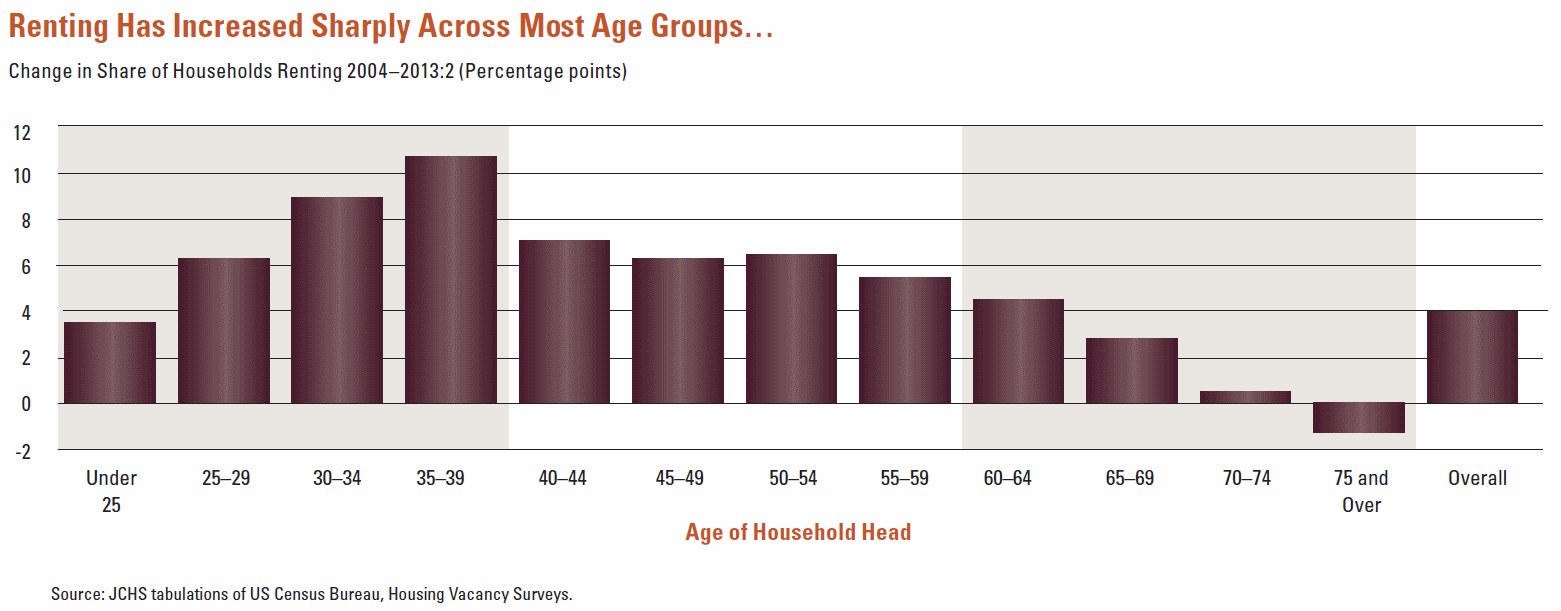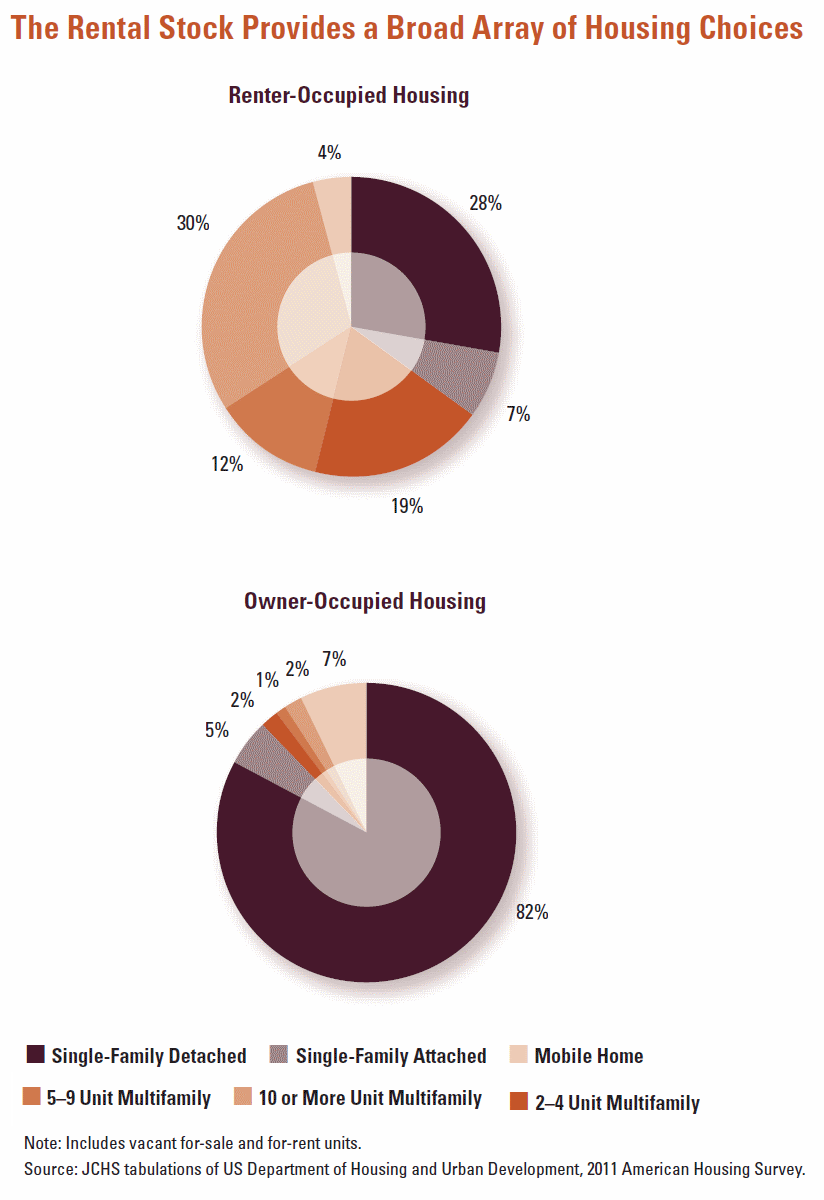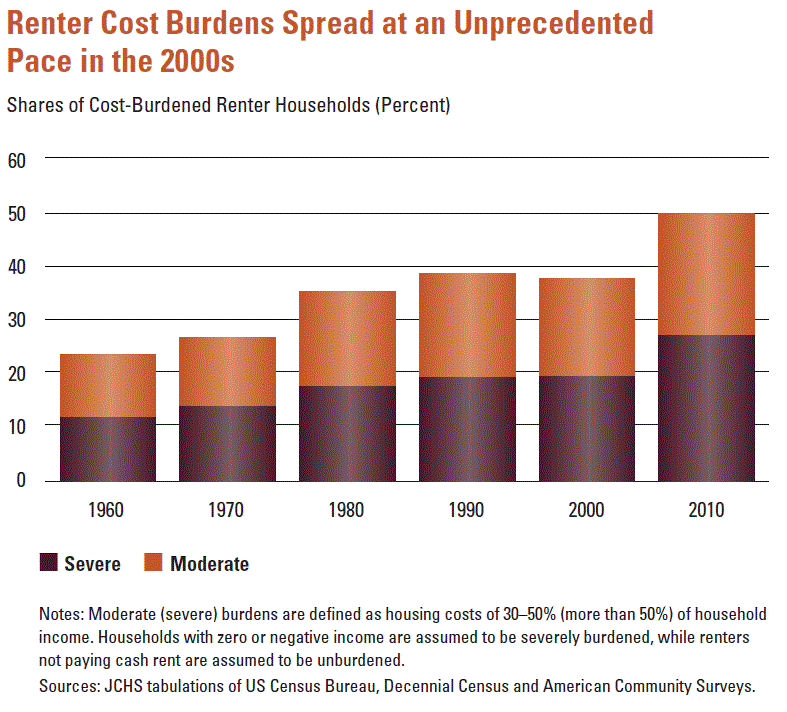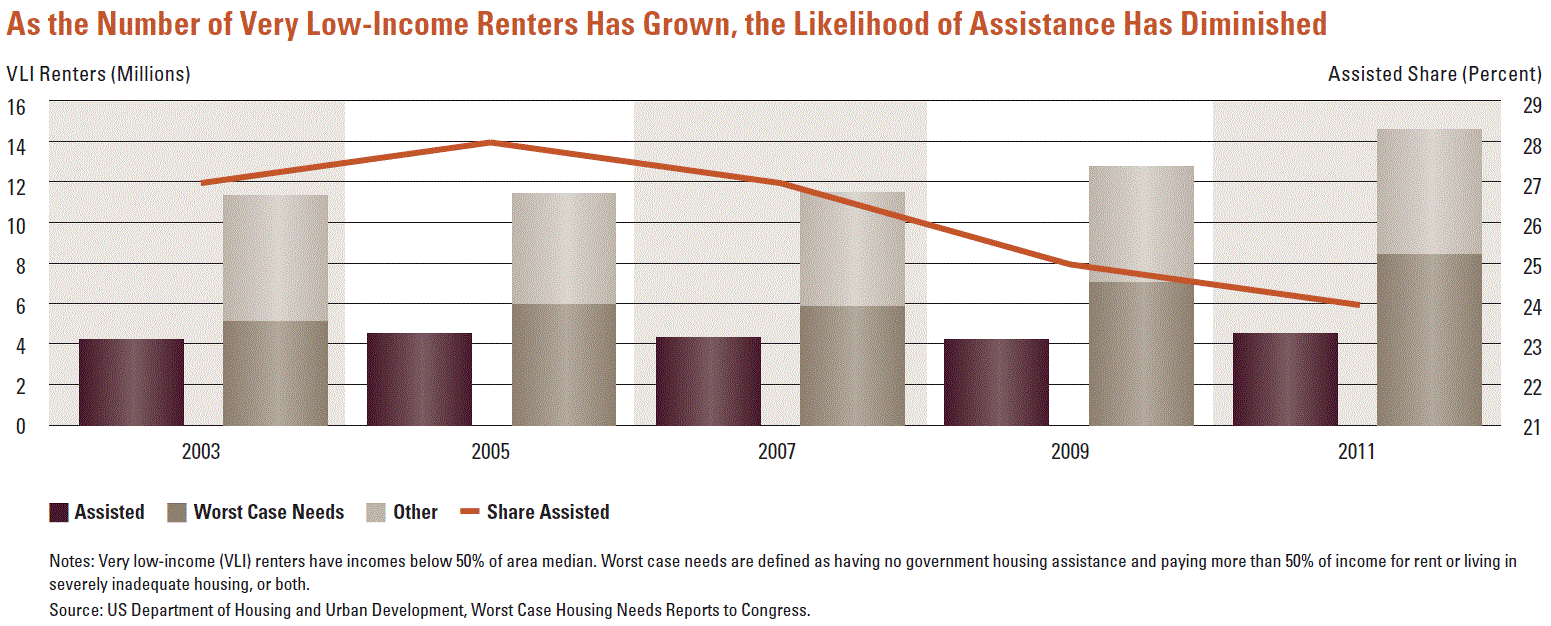Blog

The Rental Housing Affordability Crisis
A new study from the Harvard JointrnCenter on Housing Studies in conjunction with the McArthur Foundation looks atrnthe growing importance of rental housing in the U.S. as households reverserntheir long upward trend in homeownership and increasingly turn to renting. The renter share of households climbed fromrn31 percent in 2003 to 35 percent in 2013 or 43 million households. </p
The study, America’s Rental Housing:rnEvolving Markets and Needs, looks at the factors contributing to the growingrnreliance on rentals, how likely the trend is to continue and the human andrnpolicy impacts of the trend. Ofrnparticular importance, the study concludes, is the crisis presented to therncountry by the growing burden housing is placing on low and very low income households.</p
The trend toward renting has been drivenrnby several factors. The Great Recession</bbrought high levels of sustained unemployment and a flood of foreclosures whilernhighlighting some of the risks of homeownership and the benefits of renting; greaterrnease of moving, the ability to better budget for housing, and freedom fromrnmaintenance responsibilities.</p
The shift toward renting has affectedrnall but the oldest age groups with most cohorts exceeding the overall 4 percentrnincrease. Only high homeownership ratesrnamong the oldest age groups moderated the increase which made the 2000s thernstrongest decade of growth in renter households in half a century.</p
 </p
</p
The Center expects this growth torncontinue, but not at the current pace. Depending on the trajectory ofrnimmigration, they project renter household to increase by 4.0 to 4.7 millionrnover the next ten years. While thisrnwould represent a considerable slowdown from the current rate, it would still outstriprngrowth in both the 1960s and 1990s. </p
Mirroring overall population growth, minoritiesrnwill contribute virtually all of the net increase in renters over the coming decade,rnwith Hispanics alone accounting for more than half of the total. Significant sharesrnof the younger renter households will be married couples with children and single-parentrnfamilies, which together will account for another 30 percent of new renters. Thisrngroup of households will seek more spacious homes to accommodate their larger familiesrnand in locations with access to good schools and employment opportunities. The rapid increase in the senior populationrnwill lead to their higher numbers of renters. rnThis population will require some level of adaptive housing tornaccommodate them as well as assisted living. </p
While renting is more common among youngrnadults, more than a third of renters are aged 35 to 54, about the same as theirrnpopulation share. Even at stages whenrnhomeownership is greatest people still move in and out of the rental market. Againstrnstereotype, families with children account for as many renters as singlernpersons. Renters’ incomes arerndisproportionately low. Nearly a quarterrnhave annual incomes under $15,000 while only 13 percent of all households fallrninto that category. 2</p
Unlike owner-occupied housing, rentals comernin a variety of configurations. About fourrnout of ten properties are single-family homes, another fifth are in two to fourrnunit buildings and 30 percent are in buildings with 10 or more units. Rental housingrnis more likely to be located in urban areas and tends to concentrate in low-incomerncommunities. </p
 </p
</p
Much of the demand from the recentrnincrease in renter households was met by the 3.0 million units, mostly singlernfamily, that changed from owner occupied to rental property between 2007 andrn2011, pushing the share of single-family rentals up 4 percentage points, to 35 percent,rnin 2011. Institutional investors also beganrnbuying up single-family properties for rentals, testing new business models thatrnmay further expand rental housing options.</p
Rental housing has bounced back from thernGreat Recession faster than the rest of housing. Demand forced down vacancy rates and led tornrent increases and increases in landlord operating income and property values. Multi-family housing starts jumped 54 percentrnin 2011 and the improvement has been wide spread across markets.</p
The study says one aspect of the rental marketrnthat does bear watching is multifamily finance. rnCredit sources dried up there as elsewhere during the downturn withrnactivity sustained through government channels. rn</p
The situation for renters who were costrnburdened before the recession worsened during and after it. After 2007 the share of renters paying more</bthan 30 percent of their income for housing rose from 38 to 50 percent. Most of the increase was felt by thosernseverely burdened, i.e. paying more than 50 percent of their income for housingrnby 2010.</p
 </p
</p
Housing cost burdens are nearly ubiquitousrnamong the lowest-income renters. “An astounding 83 percent of renters with incomesrnof less than $15,000 were housing cost burdened in 2011, including a dismal 71 percentrnwith severe burdens. But the largest increases in shares in 2001-11 were for moderate-rnincome renters, up 11 percentage points among those with incomes of $30,000-44,999rnand 9 percentage points among those with incomes of $45,000-74,999,” the studyrnsays.</p
Unemployment accounted for some of thernincrease in housing burden but it has been even worse among households with full-timernworkers where the cost-burdened share of renters rose by nearly 10 percentage pointsrnor by 2.5 million between 2001 and 2011. </p
The consequences for those unable tornfind affordable housing the Center says is dire. They spend about $130 less on food, 40rnpercent less than those living in housing they can afford. Thus housing is clearly linked to hunger inrnthe U.S. They also spend significantlyrnless on health care and retirement savings. </p
A family with a $15,000 in annual incomernwould have to find housing that costs no more than $375 a month to stay underrnthe 30 percent level. By comparison, thern2011 median monthly cost for housing built within the previous four years was morernthan $1,000. Less than 34 percent of these new units rented under $800, and onlyrn5 percent for less than $400.”</p
Thus the gap between the demand for andrnthe supply of affordable units continues to grow. In 2011, 11.8 million renters with extremely lowrnincome competed for just 6.9 million rentals affordable at that income level. Makingrnmatters worse, 2.6 million of these affordable rentals were occupied by higher-incomernhouseholds. The study also evaluatesrnenergy costs and concludes that these costs also fall disproportionately on lowrnincome renters, either directly or as pass-throughs from land lords. </p
Housing that is affordable to low incomernrenters tends to be older and more likely to be in poor condition and so atrngreatest risk of being demolished or otherwise lost from the housing stock. Overrnthe 10 years ending in 2011, 5.6 percent of all units available for rent were removedrnfrom the inventory as were 12.8 percent of those renting for those renting for lessrnthan $400. </p
Rental subsidies are also reaching fewerrnvery low income households. Between 2007rnand 2011 the number of such renters increased by 3.3 million while the numberrnable to receive subsidies expanded by only 225,000 and the share of eligiblernhouseholds receiving assistance shrunk from 27.4 percent to 23.8 percent. The number of renters with worse case needsrnreceiving no assistance jumped by 2.6 million to 8.5 million.</p
 </p
</p
Even where funding for assistancernincreased, rising rents and falling incomes raised cost and limited the reachrnto more households. About $26 millionrnin capital investments for public housing remains unfunded and privately ownedrnhousing is rapidly aging and assistance contracts are expiring. Mandatory budget cuts under sequestrationrncould reduce vouchers by 125,000 this year. </p
So far, the Low Income Housing Tax Creditrn(LIHTC) program has been spared from sequestration but its subsidies arerninadequate to make units affordable for extremely low-income tenants, so it is oftenrncombined with other forms of assistance. The program may be endangered when debaternabout tax reform begins in earnest. </p
The study looks at the two factors whichrnit says will influence rental growth over the next decades; the growth ofrnhouseholds and prevailing attitudes toward homeownership. While economists can give some estimates ofrnthe first, the second is subject to so many influences it is nearly impossiblernto predict. </p
The study points to other issues thatrncan impact rental housing going forward; the aging housing stock, barriers tornconstruction, and the looming reform of the government related sources whichrncurrently provide most of the financing for rental units. </p
The study concludes that, despite thernmagnitude of the affordability crisis and the clear need for new thinking aboutrnassistance, active debate on rental housing policy has just begun. There are promising approaches from bothrngovernment and advocates, but as the country faces difficult choices and anrnaging population and rising health care costs strain the federal budget, itrnwould be all too easy for rental housing concerns to get lost in therndebate.
All Content Copyright © 2003 – 2009 Brown House Media, Inc. All Rights Reserved.nReproduction in any form without permission of MortgageNewsDaily.com is prohibited.
Latest Articles
By John Gittelsohn August 24, 2020, 4:00 AM PDT Some of the largest real estate investors are walking away from Read More...
Late-Stage Delinquencies are SurgingAug 21 2020, 11:59AM Like the report from Black Knight earlier today, the second quarter National Delinquency Survey from the Read More...
Published by the Federal Reserve Bank of San FranciscoIt was recently published by the Federal Reserve Bank of San Francisco, which is about as official as you can Read More...

Comments
Leave a Comment